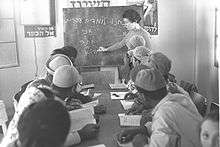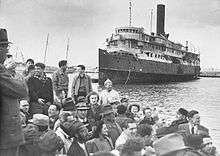Ulpan
An ulpan (Hebrew: אולפן) is an institute or school for the intensive study of Hebrew. Ulpan (plural ulpanim 'אולפנים) is a Hebrew word meaning "studio", "teaching", or "instruction".

| Part of a series on |
| Aliyah |
|---|
 |
| Jewish return to the Land of Israel |
| Concepts |
| Pre-Modern Aliyah |
| Aliyah in modern times |
| Absorption |
| Organizations |
| Related topics |
The ulpan is designed to teach adult immigrants to Israel the basic language skills of conversation, writing and comprehension. Most ulpanim also provide instruction in the fundamentals of Israeli culture, history, and geography. The primary purpose of the ulpan is to help new citizens to be integrated as quickly and as easily as possible into the social, cultural and economic life of their new country.
History
The concept of the ulpan was initiated soon after the creation of Israel in 1948. The new country was faced with a massive influx of new immigrants, refugees from war-torn Europe, oppressed and disadvantaged communities from Africa and the Middle East, and others from all parts of the world. Their language and culture varied widely. The ulpan was created to help them learn the Hebrew language and assimilate into the culture.
Ulpan Etzion in Jerusalem's Baka neighborhood was established in 1949 by Mordechai Kamerat as a model for Hebrew language education used across Israel. It was a residential facility for single olim between the ages 21 and 35 holding a bachelor's degree. Staff and students said that the atmosphere of the campus, its central location and the high quality of teaching, made it a sought-after destination.[1] One of Ulpan Etzion's notable alumni was Israeli satirist Ephraim Kishon. News anchor Haim Yavin taught there.[2]
The institution of the ulpan continues to serve immigrants today. There are numerous private facilities but the majority are run by the Jewish Agency, municipalities, kibbutzim, and the universities. Ulpanim used to be free to new immigrants (olim) to Israel. Nowadays the cost can vary depending on the type and length of the course. Since the establishment of the first ulpan in Jerusalem in 1949, more than 1.3 million new immigrants have graduated from ulpanim.[3]
_-_Vietnamese_following_the_Hebrew_teacher_in_the_Ulpan_at_the_Absorption_Center_in_Afula.jpg)
The ulpan framework has been adopted by other nations attempting to revive their own declining or lost languages. Wales, Scotland, and Norway have used the ulpan model for native language instruction. Certain language courses in Wales and Scotland have even retained the name "ulpan" (spelled "Wlpan" in Welsh and Ùlpan in Scottish Gaelic).[4][5] The Sami people of Norway sent a delegation to Israel in 2012 in order to experience Israel's ulpan program and apply its methods toward the preservation of its own threatened linguistic heritage.[6]
Kibbutz ulpan
A number of kibbutzim across Israel also offer ulpan courses. The course typically lasts 5 months and the Ulpanists will usually work part-time on the kibbutz (either 4 hours a day or 8 hours every other day, depending on the kibbutz) in addition to their studies.
Participants have the option of choosing kibbutz ulpan programs either on religious kibbutzim in the Religious Kibbutz Movement (HaKibbutz HaDati), or on secular kibbutzim.
Criticism of ulpan method
A government study in 2007 has shown that even after five months of intensive Hebrew study at ulpan, sixty percent of new immigrants over the age of thirty cannot read, write or speak Hebrew at a minimum level. The situation amongst the Russian immigrant population is even more dire with seventy percent of immigrants not being able to understand the Hebrew television news.[7]
As a result of this study, the Knesset has set up an inter-ministerial committee to study the situation and make recommendations to improve and change the ulpan system. Several alternative teaching systems are being considered for use in the ulpan framework.[8]
References
- "Closure of Baka's Ulpan Etzion's spells end of an era". jpost.com. Retrieved 16 April 2018.
- "Absorbing culture". www1.jafi.org.il. Retrieved 16 April 2018.
- Us, Israel For. "What is Ulpan". www.israelforus.com. Retrieved 16 April 2018.
- University, Bangor. "Lifelong Learning at Bangor University". www.bangor.ac.uk. Retrieved 16 April 2018.
- "Ulpan in Gaelic". ulpan.co.uk. Archived from the original on 24 July 2012. Retrieved 16 April 2018.
- Cheslow, Daniella (12 March 2012). "Nordic people see hope of preserving culture, language in Hebrew revival". The China Post. Jerusalem. AP. Retrieved 12 March 2012.
- "haaretz.com - Most ulpan graduates over 30 are unable to read or write Hebrew fluently". haaretz.com. Retrieved 16 April 2018.
- Inter-ministerial committee discusses the crisis in the ulpan system (in Hebrew)